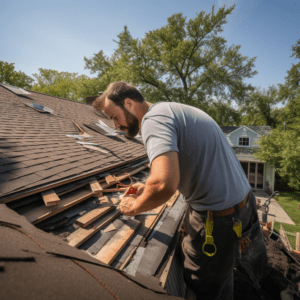According to recent statistics, the field of modern roofing designs has experienced significant advancements in sustainable materials, innovative styles, and energy-efficient solutions. This article aims to provide a knowledgeable and informative overview of contemporary roofing trends, creative options, stylish ideas, cutting-edge technologies, and unique designs. By examining these various aspects of modern roofing, readers can gain a comprehensive understanding of the current landscape in this industry.
Key Takeaways
- Modern roofing designs prioritize functionality and aesthetics, aiming to protect buildings while contributing positively to the environment.
- Advancements in technology enable the integration of green roofs and solar panels into modern roofing designs, improving energy efficiency and sustainability.
- These designs utilize innovative materials and techniques to enhance building performance and longevity, promoting sustainable practices in the construction industry.
- Modern roofing designs not only serve to protect buildings but also enhance the overall architectural design, creating visually appealing structures.
Sustainable Roofing Materials
Sustainable roofing materials have gained significant attention in recent years due to their ability to reduce environmental impact and promote long-term energy efficiency. These materials are designed to minimize the negative effects of traditional roofing on the environment while maximizing performance and durability.
One example of a sustainable roofing material is solar reflective shingles. These shingles are made with special coatings that reflect sunlight, reducing heat absorption and keeping buildings cooler. This reduces the need for air conditioning, leading to lower energy consumption and decreased greenhouse gas emissions.
Another sustainable option is green roofs, also known as living roofs or vegetative roofs. Green roofs consist of a layer of vegetation planted on top of a waterproof membrane. They provide numerous benefits such as improved insulation, rainwater retention, and reduced urban heat island effect.
Furthermore, recycled roofing materials have gained popularity in sustainable construction practices. These materials are made from recycled products such as rubber tires or plastic bottles, diverting waste from landfills and reducing the need for virgin resources.
Overall, sustainable roofing materials offer an environmentally friendly alternative to traditional roofing options. By choosing these materials, individuals can contribute to a greener future by reducing energy consumption and minimizing waste production.
Innovative Roofing Styles
Innovative roofing styles have brought about the use of unique materials that offer a range of benefits. These materials are not only durable and long-lasting, but they also provide eco-friendly options for homeowners. By utilizing sustainable materials such as recycled metal or solar panels, these roofs can have a positive impact on energy efficiency by reducing heat transfer and lowering energy consumption.
Unique Materials Used
Exotic and unconventional materials are increasingly being utilized in contemporary roofing designs. These unique materials offer a range of benefits, including improved durability, energy efficiency, and aesthetic appeal. One such material is living roofs, which involve the use of vegetation to create a natural and sustainable roof surface. Living roofs not only provide insulation but also absorb rainwater and reduce stormwater runoff. Another unconventional material gaining popularity is solar tiles or shingles that seamlessly integrate with traditional roofing materials while harnessing solar energy for electricity generation. These innovative roofing materials not only contribute to the sustainable design movement but also add visual interest to architectural structures. As technology advances and more research is conducted in this field, we can expect further exploration and implementation of exotic and unconventional materials in contemporary roofing designs.
Eco-Friendly Options Available
Eco-friendly options for roofs include materials that prioritize environmental conservation and minimize the negative impact on ecosystems. The demand for sustainable building practices has led to the development of various roofing solutions that reduce energy consumption, enhance insulation, and promote water conservation. One such option is green roofs which involve covering rooftops with vegetation. Green roofs provide numerous benefits such as reducing stormwater runoff, improving air quality, and mitigating urban heat island effect. Another eco-friendly choice is solar panels that convert sunlight into electricity, reducing reliance on fossil fuels and decreasing carbon emissions. Additionally, there are cool roofs designed to reflect more sunlight and absorb less heat compared to traditional roofing materials. These roofs help mitigate urban heat island effect by lowering temperatures in densely populated areas. Overall, these eco-friendly roof options contribute towards sustainability efforts by minimizing environmental impact while providing functional benefits to buildings.
Impact on Energy Efficiency
The impact on energy efficiency can be measured by analyzing the reduction in energy consumption achieved through the use of eco-friendly roofing materials and techniques. Eco-friendly roofing materials, such as cool roofs and green roofs, have been shown to significantly decrease energy consumption in buildings. Cool roofs are designed to reflect more sunlight and absorb less heat compared to traditional dark-colored roofs, resulting in lower cooling costs during hot weather. Green roofs, on the other hand, provide insulation and reduce heat transfer into buildings, leading to reduced heating requirements during colder months. Additionally, both cool roofs and green roofs help mitigate the urban heat island effect by reducing surface temperatures and improving air quality. These environmental benefits contribute not only to decreased energy usage but also to improved overall building sustainability.
Popular Roofing Trends
This paragraph will discuss the key points of sustainable roofing options and innovative material choices. Sustainable roofing options are becoming increasingly popular as people strive to minimize their environmental impact. These options include green roofs, which incorporate vegetation to improve energy efficiency and reduce stormwater runoff, as well as solar panels that generate clean energy. Additionally, there is a growing trend towards using innovative materials such as recycled shingles or rubber roofing that offer durability and reduced maintenance requirements.
Sustainable Roofing Options
Sustainable roofing options can be characterized by their ability to minimize environmental impact and promote long-term energy efficiency. One such option is the use of green roofs, which involve the installation of vegetation on a building’s roof surface. Green roofs offer multiple environmental benefits, including improved air quality, reduced stormwater runoff, and increased insulation, which can lead to energy savings. Another sustainable roofing option is the use of cool roofs, which are designed to reflect more sunlight and absorb less heat compared to traditional roofs. This helps to reduce the urban heat island effect and lowers cooling costs for buildings. Additionally, solar panels can be incorporated into roofing systems to generate renewable electricity while providing protection from the elements. Overall, these sustainable roofing options contribute towards creating more environmentally-friendly buildings and reducing energy consumption in the long term.
Innovative Material Choices
Sustainable roofing options have paved the way for innovative material choices in modern roof design. These materials offer improved durability, energy efficiency, and reduced environmental impact. One such option is green roofs, which incorporate vegetation into a waterproofing layer to provide insulation, absorb rainwater, and reduce urban heat island effect. Another choice is solar panels integrated into roofing materials, allowing for the generation of renewable energy while protecting the building from weather elements. Additionally, advanced synthetic materials such as polycarbonate panels offer lightweight and durable solutions that can mimic traditional roofing styles while providing better resistance to UV rays and extreme weather conditions. Furthermore, the use of recycled or reclaimed materials like metal shingles made from old cars or rubber tiles made from discarded tires contribute to sustainable practices in the construction industry. These innovative material choices not only enhance the performance and longevity of roofs but also promote eco-friendly alternatives in building design.
Contemporary Roofing Designs
Contemporary roofing designs incorporate innovative materials and techniques to enhance functionality and aesthetics. These designs are characterized by their focus on sustainability, energy efficiency, and durability. One key material that is commonly used in modern roofing designs is metal. Metal roofs are known for their longevity, as they can last up to 50 years or more with minimal maintenance. They are also highly resistant to fire, wind, and impact damage, making them a popular choice for areas prone to extreme weather conditions.
Another innovative technique used in contemporary roofing design is the integration of green roofs. Green roofs consist of a layer of vegetation planted over a waterproofing membrane, providing numerous benefits such as improved insulation, reduced stormwater runoff, and increased biodiversity in urban areas. Additionally, green roofs contribute to the overall aesthetic appeal of buildings by adding natural elements and creating a harmonious connection between the built environment and nature.
Furthermore, advancements in technology have led to the development of solar roof tiles which allow for the generation of electricity from sunlight. These tiles blend seamlessly with traditional roofing materials while harnessing renewable energy sources.
Overall, contemporary roofing designs demonstrate a commitment to sustainable practices while prioritizing both functionality and aesthetics. By incorporating innovative materials and techniques into these designs, architects and engineers are able to create roofs that not only protect buildings but also contribute positively to the environment.
Energy-Efficient Roofing Solutions
Energy-efficient roofing solutions have become a crucial aspect of sustainable building practices. Integrating solar panels into roof designs allows for the harnessing of renewable energy, reducing reliance on traditional power sources and lowering carbon emissions. Additionally, the use of reflective roofing materials helps to mitigate heat absorption, improving energy efficiency by reducing cooling needs. Furthermore, advancements in insulation technology have resulted in more efficient and cost-effective options that enhance thermal performance and minimize heat transfer through roofs, further contributing to energy conservation efforts.
Solar Panel Integration
Integrating solar panels into roofing designs has gained significant attention in recent years due to its potential to harness renewable energy sources. This innovative approach allows buildings to generate their own electricity and reduce their reliance on traditional power grids. By seamlessly integrating solar panels into the roof, these systems can provide clean and sustainable energy without compromising aesthetic appeal. The integration process involves careful planning and coordination between architects, engineers, and solar panel manufacturers to ensure optimal performance and structural integrity. Different types of solar panel technologies, such as monocrystalline or thin-film solar cells, can be incorporated into the roofing materials, depending on specific design requirements. Additionally, advancements in solar panel efficiency and cost-effectiveness have made this integration more feasible for a wider range of building projects. As the demand for renewable energy solutions continues to grow, integrating solar panels into roofing designs presents a promising way forward in achieving sustainable development goals.
Reflective Roofing Materials
Reflective roofing materials have gained popularity in recent years due to their ability to reduce heat absorption and lower energy consumption in buildings. These materials are designed to reflect a significant portion of the sun’s radiation, thereby reducing the amount of heat that is transferred into the building. They typically have a high solar reflectance index (SRI), which measures their ability to reflect solar energy. Reflective roofing materials can be made from various substances such as metal, asphalt, or tiles coated with reflective pigments or coatings. They can help mitigate the urban heat island effect by reducing surface temperatures and lowering cooling demands in buildings. Additionally, these materials contribute to improved indoor comfort and can lead to energy savings by reducing the need for air conditioning during hot weather conditions.
Insulation Efficiency Advancements
Advancements in insulation efficiency have contributed to significant improvements in reducing heat transfer and increasing energy savings in buildings. Insulation plays a crucial role in maintaining thermal comfort and reducing energy consumption. Traditional insulation materials, such as fiberglass and cellulose, have been widely used but are not always efficient at preventing heat loss or gain. However, recent developments in insulation technology have led to the emergence of more effective solutions. For instance, the use of spray foam insulation has gained popularity due to its ability to create an airtight seal that minimizes heat transfer through conduction and convection. Additionally, advancements in reflective insulation materials, such as radiant barriers, can further enhance energy efficiency by reflecting radiant heat away from the building envelope. These innovative approaches provide improved thermal performance while also contributing to reduced energy consumption and greenhouse gas emissions in buildings.
Modern Roofing Materials
Roofing materials in modern designs have evolved significantly, incorporating innovative technologies and materials to enhance their performance and durability. These advancements aim to address the challenges posed by changing weather patterns, increased energy efficiency requirements, and sustainability concerns. One such material is the use of solar reflective coatings on roof surfaces, which can reduce heat absorption and lower cooling costs for buildings. Additionally, there has been a shift towards using more sustainable materials such as recycled content shingles, clay tiles, or metal roofing systems that are not only durable but also environmentally friendly.
Another notable development in modern roofing materials is the incorporation of insulation layers within the roofing system. This helps improve thermal performance by reducing heat transfer between the interior and exterior environments. Insulation materials like polyurethane foam or rigid boards are commonly used to provide enhanced energy efficiency and comfort levels.
Furthermore, manufacturers have introduced self-adhering membranes that eliminate the need for torches or hot asphalt during installation, making it safer and quicker. Moreover, these membranes offer excellent waterproofing capabilities while maintaining flexibility to accommodate building movement.
Overall, modern roofing materials demonstrate a commitment to improving performance while considering environmental impact factors. The integration of advanced technologies and sustainable practices allows for greater longevity and functionality in today’s roofing designs.
Creative Roofing Options
Innovative approaches to constructing roofs have allowed for the incorporation of unique and aesthetically pleasing elements that enhance the overall architectural design of buildings. One creative roofing option is the green roof, also known as a living roof. This type of roof is covered with vegetation, providing a range of benefits including improved insulation, reduced stormwater runoff, and increased biodiversity. Green roofs can be extensive or intensive, depending on the depth of soil and the variety of plants used.
Another creative roofing option is the use of solar panels. Solar panels are becoming increasingly popular as they harness renewable energy from the sun to generate electricity. These panels are typically installed on top of roofs where they can capture sunlight efficiently. The integration of solar panels into roofing systems not only provides environmental benefits but also contributes to energy cost savings for building owners.
Furthermore, there has been an emergence in translucent roofs that allow natural light to penetrate into interior spaces. This innovative approach enhances daylighting, reducing dependency on artificial lighting during daytime hours and creating a more pleasant indoor environment.
Lastly, some architects have incorporated unique shapes and materials into their roofing designs to create visually striking structures. These include curved roofs made from lightweight materials such as aluminum or steel, which add an element of elegance and sophistication to modern buildings.
Overall, these creative roofing options demonstrate how advancements in construction techniques have facilitated the inclusion of unique elements that enhance both functionality and aesthetics in modern architectural designs.
Stylish Roofing Ideas
Stylish roofing ideas have emerged in contemporary architecture, showcasing creative approaches that enhance the visual appeal of buildings. One such idea is the use of green roofs, which involve covering rooftops with vegetation to create a natural and aesthetically pleasing environment. Green roofs offer numerous benefits, including improved insulation, reduced stormwater runoff, and increased biodiversity. They also provide a visually striking contrast to traditional roofing materials.
Another stylish roofing idea is the incorporation of skylights or roof windows. These design elements allow natural light to flood into interior spaces, creating an open and airy atmosphere while reducing the need for artificial lighting during daylight hours. Skylights can be installed in various shapes and sizes to suit different architectural styles and preferences.
Additionally, modern roofing designs often feature bold and unconventional materials. For instance, metal roofs are becoming increasingly popular due to their durability and sleek appearance. Metal panels can be shaped in unique ways to add interest and texture to a building’s exterior.
Cutting-Edge Roofing Technologies
Cutting-edge technologies in the field of architecture have led to advancements in materials and construction methods that enhance the functionality and performance of roofs. These innovations have revolutionized roofing systems, allowing for greater durability, energy efficiency, and design possibilities.
One such technology is the use of photovoltaic (PV) panels integrated into roofing materials. PV panels convert sunlight into electricity, providing a sustainable source of power for homes and buildings. This integration eliminates the need for separate solar panels, enhancing the aesthetic appeal of rooftops while harnessing renewable energy.
Additionally, advancements in insulation materials have improved thermal performance in roofs. High-performance insulation materials such as spray foam or rigid foam boards can effectively reduce heat transfer and air leakage, resulting in lower energy consumption for heating or cooling purposes.
Furthermore, the development of lightweight yet strong roofing materials like composites or engineered woods has enhanced structural integrity without adding excessive weight to buildings. This allows for larger spans between supports and more flexible architectural designs.
Lastly, innovative coating technologies have been introduced to roofs to increase their longevity and protect against environmental factors such as UV radiation or water damage. Reflective coatings can also reduce heat absorption from sunlight, further improving energy efficiency.
Unique Roofing Designs
A variety of unconventional approaches to roof design have been explored, resulting in visually striking and structurally unique solutions. One such approach is the use of green roofs, which involve covering the roof surface with vegetation. Green roofs provide numerous benefits, including improved insulation, reduced stormwater runoff, and increased biodiversity. Another innovative design is the use of skylights or solar tubes to bring natural light into interior spaces. This not only reduces the need for artificial lighting but also creates a more pleasant and inviting environment. Additionally, architects and engineers have experimented with curved roofs that offer both aesthetic appeal and structural advantages. These curved designs distribute weight evenly across the structure, improving its stability and resistance to wind loads. Moreover, there has been an increasing interest in incorporating renewable energy systems into roof designs. Solar panels can be integrated seamlessly into roofing materials to generate clean electricity while maintaining a sleek appearance. Overall, these unique roofing designs showcase the endless possibilities for creating functional yet visually appealing structures that meet today’s architectural demands.




